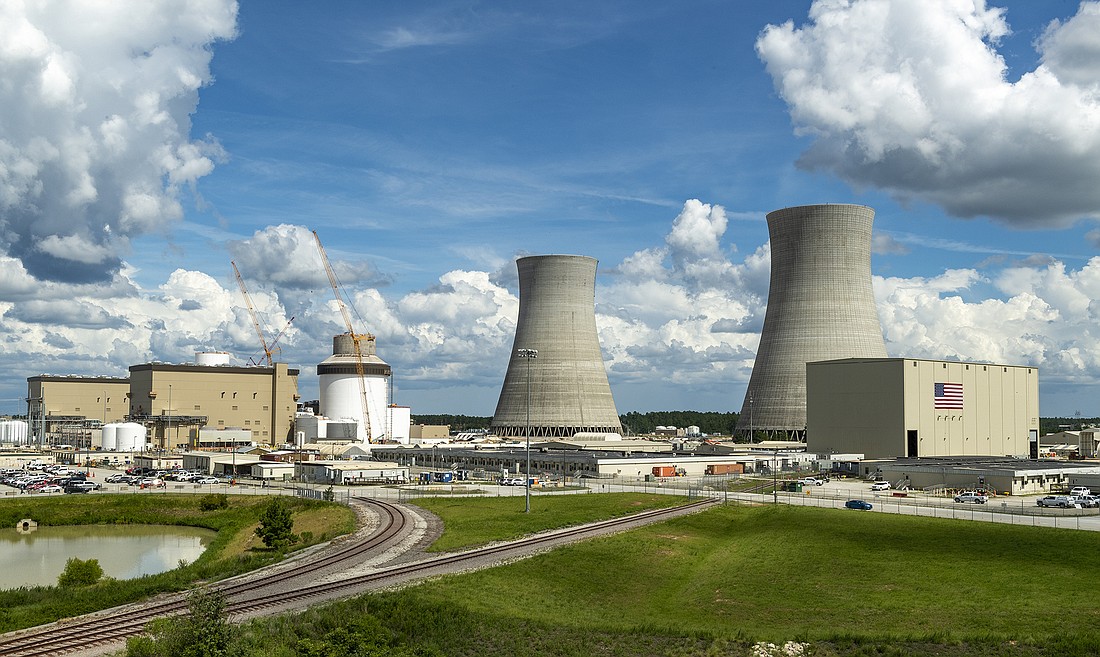
In August, JEA leadership received something rare in its costly saga to start drawing power from the long-delayed expansion of Georgia nuclear Plant Vogtle — good news.
The federal Nuclear Regulatory Commission gave plant co-owner Georgia Power affiliate Southern Nuclear the go-ahead to load fuel into Unit 3, which has been under construction since 2013.
During JEA’s annual board of directors retreat Aug. 10, officials noted the development as a positive sign after years of setbacks.
JEA’s 2021 annual discourse report says the utility estimates it will pay $3.369 billion in capital costs for the $30.34 billion construction of the nuclear plant through a power purchase agreement with one of the four Vogtle co-owners, Municipal Electric Authority of Georgia.
Unexpected construction delays or problems could send those figures higher.
History of troubles
The project has suffered multiple cost overruns over the years. By contrast, in 2013 the project was expected to cost $14.3 billion.
Those increasing costs have led to lawsuits and utilities, including JEA, seeking to shield themselves from paying more.
To prevent a larger financial burden, JEA is asking MEAG to cap its Vogtle costs at the expense of losing out on some energy from the agreement.
An Aug. 8 letter from JEA CEO Jay Stowe to MEAG President and CEO James E. Fuller seeks to exercise a one-time contract tender option to release a portion of MEAG’s ownership interest to Georgia Power —a mechanism built into the ownership contract if construction costs got too high.
In exchange, Georgia Power would pay all of the project’s remaining construction costs.
For MEAG’s members and JEA, this would mean they would owe no more if the price of the plant increases.
The catch: All 39 MEAG members that would receive power from Vogtle must agree to the tender option.
If not all members agree, JEA is asking to give up a proportionate share of the energy capacity it would receive in the power purchase agreement for the same cost as if MEAG had exercised the tender.
An Aug. 29 email from JEA officials shows the utility’s cost in the Plant Vogtle contract will add $30 to $42 annually to a residential customer’s energy bills through 2032.
Stowe said he doesn’t want further construction issues to make the impact worse.
“Part of the risk that we see is that if something else were to happen during the construction between now and when it goes online for commercial operations, we would have to pay that too,” Stowe said in an Aug. 10 interview.
“If we can cap the costs, then we save our customers money.”
Waiting for power
Georgia Power says it expects Unit 3 to be operational in March 2023 and Unit 4 in Dec. 2023.
JEA signed the 20-year power purchase agreement with MEAG in 2008 to draw 206 megawatts of power from the new nuclear plant.
The Union of Concerned Scientists says a typical coal plant is about 600 megawatts.
Georgia Power is majority owner of Plant Vogtle with smaller stakes owned by Oglethorpe Power Corp, MEAG and Dalton Utilities, according to Georgia Power’s website.
At the time, JEA officials saw it as an opportunity to add carbon-free power to its energy portfolio, as well as diversify its fuel mix.
JEA historically has been reliant on predominantly carbon-emitting sources like coal, fuel oil, petroleum coke and natural gas as well as other power purchase agreements.
Stowe said Aug. 10 that he attended MEAG’s annual meeting and laid out the financial case for the Vogtle owners to take the tender option.
A chart in the JEA board retreat material shows the Vogtle co-owners and power purchasers would pay a combined $21.66 billion without the tender option if there are no more construction delays.
That would drop to a collective $18.87 billion if the owners use the tender option.
JEA Vice President of Financial Services Joe Orfano said Aug. 10 that JEA’s share of the cost reduction would be about $315 million with an affordable replacement for the lost power.
A utility spokesperson said in an Aug. 30 email that the tender will save JEA $10 million to $15 million per year.
The Aug. 29 email said JEA has yet to receive a response from MEAG regarding its tender proposal.
Convincing Georgia Power to agree to the tender offer may not be easy.
JEA Chief Administrative Office Jody Brooks told the board Aug. 10 there is “sensitivity” on the tender issue because of ongoing litigation about the plant’s growing costs.
According to reports by the Atlanta Journal-Constitution, Oglethorpe and MEAG sued Georgia Power. The newspaper reported July 22 that Dalton Utilities stopped its spending on the project.
Vogtle and electric rates
During the JEA board of directors annual retreat Aug. 10, Stowe said JEA’s cost for Plant Vogtle is expected to be the main trigger for rate increases in the coming years.
Without the tender offer, the utility says JEA residential customers that use 1,000 KWH could see an average of $2.50 to $3.50 a month added to their base rate bill from fiscal years 2023-2032.
If JEA sees relief from Plant Vogtle, it still will have to replace the lost power from other sources.
“If we tender and can replace that energy for less than $135 per megawatt hour is the right call for us,” Stowe said. “It saves us money.”
Long term, JEA is drafting an Integrated Resource Plan, expected to be released in spring 2023 that projects the region’s future electric needs, accounting for electric vehicles and other market changes.
“That’s a 20-year contract (with MEAG),” Stowe said. “At the end of 20 years, we have to be able to replace 200 megawatts of carbon-free energy.”